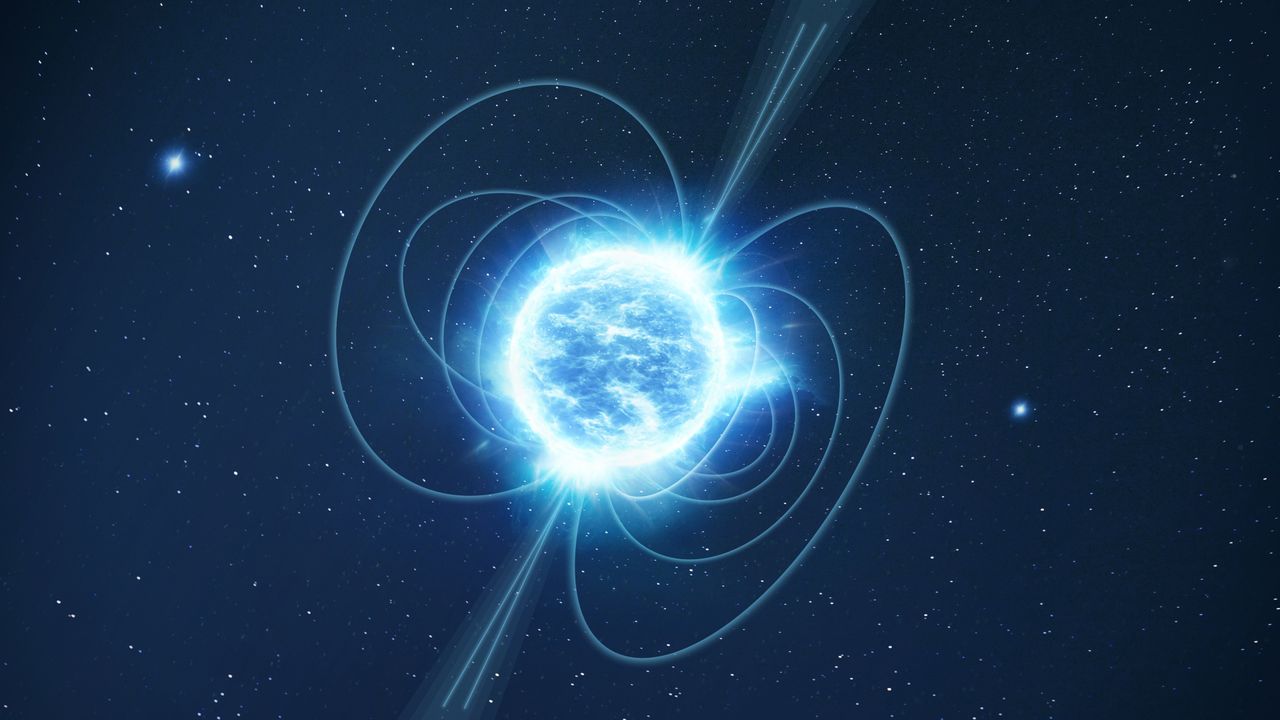
By developing a new theoretical relation describing just how compact neutron stars — which are the remnants of massive stars that have gone supernova — can get, researchers have found a way to test the properties of nuclear physics under very extreme conditions.
As the collapsed core of a massive star, a neutron star is a small but incredibly dense object, packing up to three times the mass of our sun into a small volume. Models predict that neutron stars are about a dozen or so miles across, but their exact radius has always been unclear.
Rezzolla and his Frankfurt colleague, Christian Ecker, have now made things a little clearer with their new study into the compactness of neutron stars.
There are several reasons why it’s difficult to determine the radius of a neutron star. One obstacle is that all the known neutron stars are very far away, but the main challenge revolves around what physicists call the equation of state. This describes the density and pressure within the interior of a neutron star, from which the radius and other properties can be accurately derived.
The trouble is, the conditions inside a neutron star are so extreme that they push our understanding of nuclear physics to the limit. A spoonful of neutron star material can weigh billion tons. Under that intense pressure, atoms are crushed and positively charged protons merge with negatively charged electrons to produce an object full of neutrons.
But at the heart of a neutron star, exotic physics may prevail: for example, “strange” matter particles called hyperons may exist, or perhaps the immense gravity causes even neutrons to mush together and force the quark particles they are made from flow almost freely. There’s no way to test any of this, however, because scientists are unable to replicate the conditions inside a neutron star in a laboratory on Earth. It’s just too extreme.
So, rather than there being one equation of state for neutron stars, there is a whole list of possible equations of state, one for each model describing possible conditions inside a neutron star.
To assess how compact a neutron star can become, Rezzolla and Ecker considered tens of thousands of equations of state. To make things more manageable, however, they looked at only the most massive neutron star possible in each case.
“A well-known result in general relativity is that for each equation of state there is a maximum mass allowed,” said Rezzolla. “Any mass larger than the maximum mass would lead to a black hole. We know from observations that the maximum mass allowed should be somewhere between two and three solar masses.”
Rezzolla and Ecker were surprised to find that an upper limit exists for the compactness of a neutron star, and that based on this, the ratio between the neutron star’s mass and its radius is always smaller than 1/3.
This ratio can be determined thanks to what are known as geometrized units, which are commonly used in the physics of general relativity and allow mass to be expressed in length rather than weight.
“Because we set an upper limit on the compactness, we can set a lower limit on the radius,” said Rezzolla. “Once we measure a neutron star’s mass, we could say that its radius should be larger than three times its mass.”
Rezzolla and Ecker also found that this ratio holds for all equations of state regardless of what their maximum mass is. This might at first seem surprising since one would automatically think that the most massive neutron stars would be the most compact because they’d have stronger gravity trying to make them contract. Instead, the exotic nuclear physics at play within neutron stars seems to override this and balance things out.
The relation is derived partially from the principles of quantum chromodynamics, or QCD, which is the theory of how the strong force binds particles called quarks to form particles such as neutrons. The strong force is carried by particles called gluons (the name coming from the fact that they glue quarks together) and QCD is the quantum field theory that governs them, giving them a quantum number whimsically known as “color charge.”
Rezzolla and Ecker applied certain standard assumptions based on QCD to derive their compactness relation — they describe it as QCD leaving an “imprint” on the interior structure of neutron stars. This means that if it ever becomes possible to measure the radius of a neutron star precisely, then any deviation from this relation would be a big clue that something is amiss with our understanding of QCD.
“If we were to see a violation of this result, such as a neutron star with a compactness greater than 1/3, then this would indicate that there is something wrong in the QCD assumptions that we have employed,” said Rezzolla.
It may be that we won’t have to wait too much longer to be able to make an accurate observation of a neutron star’s radius, whereby this relation and QCD could subsequently be tested. Rezzolla describes the prospects as “optimistic” and cites the NICER (Neutron star Interior Composition Explorer) experiment on the International Space Station, and also measurements from gravitational wave events, some of which involve the merger of a black hole with a neutron star. Only in one case so far, GW 170817, have two neutron stars been involved in a merger.
“If we could only see more events like GW 170817, we could set much tighter constraints on the possible radii of neutron stars,” said Rezzolla.
Rezzolla and Ecker’s research is published in a on the pre-print paper repository arXiv.

